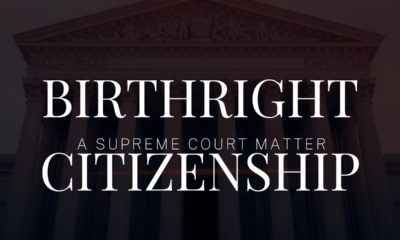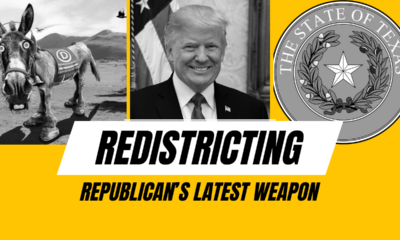Constitution
Greater Idaho pushing harder
Greater Idaho took definite steps closer to fruition, with the Idaho House of Representatives extending its invitation to join.
The Greater Idaho movement, the most prominent interstate secession movement in the United States today, passed some more obstacles. A bill to invite Oregon’s eastern counties to join Idaho has passed Idaho’s lower house. Furthermore, Greater Idaho sympathetic Senators have introduced a bill in the Senate of Oregon to discuss letting those counties go. Success is far from certain, but Greater Idaho is now significantly closer to it.
Motives for Greater Idaho
Greater Idaho refers both to an Idaho including Oregon’s eastern counties, or the organization hoping to bring that about. That organization’s leaders want to live under a conservative government, not a leftist one. And they lament the consistent outvoting of conservative eastern Oregonians, mainly by residents of Multnomah, Marion, Polk, and Lane Counties. Those are the counties where lie the cities of Portland, Salem (which straddles Marion and Polk), and Eugene. Portland, especially, competes heavily for the distinction of America’s Woke-est City. CNAV has a wealth of reportage on the sorry state of life in Portland, including among other things:
- Starbucks closing some of their latte bars in Portland because the local denizens attack their customers and baristas,
- The Mayor of Portland dealing with homeless camps near school walking routes,
- The spectacle of murder suspects getting bailed out, then murdering others while out on bail,
- Coffee shop owners suffering vandalism because they sponsor events friendly to the police, and:
- Political vandalism – like the “unsub” who spray-canned a murderous message on an anti-abortion billboard in Portland.
Governor Kate Brown – who won re-election by the skin of her teeth last Midterms – commuted all death sentences last December. “Death is an irreversible punishment,” she said. Well, murder is an “irreversible” crime. Last November, she also pardoned thousands of marijuana-possession convicts. That last act might further incense Idahoans, who already see Oregon’s permissiveness in this area as a values threat.
Latest news
The last time CNAV talked about this, Greater Idaho had improved their tally of counties voting to join Idaho from nine to eleven. Morrow and Wheeler Counties passed their Yes resolutions last Midterms. But county officials in Wallowa County were denying that Greater Idaho signature gatherers had the signatures to put a “Yes” referendum on the ballot. (Greater Idaho formally submitted a petition on December 29, 2022. The Wallowa County Clerk has since acknowledged that the organization had enough signatures. Wallowa County will vote on May 23.) That still leaves Gilliam, Umatilla, Crook, Deschutes, and Wasco Counties even to consider voting on secession. (Klamath, Lake, Harney, Malheur, Grant, Baker, Union, Jefferson, and Sherman Counties have already voted Yes.)
On January 10, Greater Idaho reported that a bill to invite the State of Idaho to start talking about relocating the Oregon-Idaho border had had a first reading in the Senate of Oregon. The bill (SJM 2) sets forth several historical findings. Among them: Oregon and Washington State adjusted their border in 1958. So this wouldn’t be the first movement of an Oregon border – though everyone knows that the earlier movement was not nearly so drastic.
Idaho extends an invitation
Then came the event that has given Greater Idaho its greatest impetus thus far. On February 1, Idaho State Reps. Judy Boyle and Barbara Ehardt introduced HJM 1, a bill to invite Oregon to talk to Idaho about moving the border. The bill went to the Oregon House Committee on State Affairs:
Rep. Boyle listed several advantages to Idaho of becoming Greater Idaho:
- Adding a population of 380,000 (and a U.S. House seat) immediately,
- $170 million more in tax revenues, not even including increased revenue from businesses that could operate with many fewer restrictions,
- Allowing Oregonians to become Idahoans without moving into existing Idaho, thus sparing Idaho crowding and traffic problems, and
- Eliminating a source of marijuana and hard drugs, which in the moving Oregon counties would become illegal once more.
Rep. Boyle cited a Claremont Institute study on the economic impact of moving the border. Claremont found that eastern and southern Oregon are a drain on the State’s budget. Portland’s high-income residents are paying for the privilege of counting eastern and southern Oregon as a part of their State. They pay to the tune of $360 per resident per year, or $690 per wage earner per year. Would Idahoans get stuck with that kind of tab? No! According to Claremont, the region could easily pay for its upkeep and see 2.1% growth in Gross Domestic Product.
On February 13, the Idaho House passed HJM 1, 41-28.
Greater Idaho has the evidence – but do they have the momentum?
Greater Idaho quickly pointed out the results of a poll of residents of the Willamette Valley. Recall: residents of northwestern Oregon subsidize southern and eastern Oregon to the tune of $690 per wage earner per year. Only three percent of residents surveyed in Willamette Valley are willing to pay more than $500 a year. Do those residents not know how much they’re paying as it is? Maybe some of them found out last year before the taking of this poll. 68 percent of the sample said yes, Oregon should look into letting those counties go. Only 20 percent said no; the rest weren’t sure. Moreover, sixty-six percent of Democrats in that valley said yes.
An even larger majority – 81 percent – wanted Oregon to try to address the discontent in the eastern and southern counties. That included 79 percent of Democrats.
The Willamette Valley is Oregon’s wine country – their counterpart to California’s Napa Valley. That valley includes all the three major cities of Oregon: Portland, Salem and Eugene. If Greater Idaho succeeds in its vision, 11 percent of Valley residents said they would very likely move. Another 11 percent said they were “somewhat likely” to move to the new Idaho. This included 50 percent of conservative residents of the Valley.
Analysis
Results like these show the only reason for Oregon’s leaders to tighten their grip on the eastern and southern counties, is spite. True, Oregon would hand over a House district to Idaho. But that would be Oregon’s Second District, which is Republican anyway. The movement of conservatives out of the Willamette Valley might “flip” Oregon’s Fifth District from Republican back to Democratic. Democrats have “carried the District” in the three most recent Presidential elections. So the only thing the national Democratic Party would lose, would be one electoral vote – from Oregon to Idaho.
CNAV has not seen any polling in northwestern Oregon outside the Willamette Valley. But at least within the valley, Democratic voters are not so spiteful. Convince them that they could save $690 per wage earner per year in taxes if they would “let those counties go,” and they’d vote in a heartbeat to let them go.
Idaho would have little reason to fear that those extra 380,000 residents would “flip” Idaho Democratic. Rep. Cliff Bentz (R-Oregon-2nd) shellacked his Democratic opponent two to one at Midterms. Those who voted for him, have also voted to join Idaho, and with high enthusiasm.
Of course, Oregon and national Democrats might not want to admit that the rural-urban divide is such that rural folk no longer feel they have adequate representation in their legislature. And to be “woke” is to be spiteful, and extremely so. Nevertheless, sheer practicality might dictate letting Greater Idaho come to fruition.
About the image
The map of Oregon, showing the boundary of Greater Idaho, county lines, and current Oregon Senate districts, appears courtesy of the Greater Idaho organization. They have released this map and several other illustrations as uncopyrighted graphics for use by the media.
Terry A. Hurlbut has been a student of politics, philosophy, and science for more than 35 years. He is a graduate of Yale College and has served as a physician-level laboratory administrator in a 250-bed community hospital. He also is a serious student of the Bible, is conversant in its two primary original languages, and has followed the creation-science movement closely since 1993.
-

 Civilization2 days ago
Civilization2 days agoDC Pipe Bomb Arrest Raises Questions About Christopher’s Wray’s FBI
-

 Civilization5 days ago
Civilization5 days agoYoo Hoo, VP Vance—Your Character is Showing!
-

 Executive5 days ago
Executive5 days agoThe Last Supper: New York’s Socialist Feast
-

 Guest Columns4 days ago
Guest Columns4 days agoCongressional Leaders See Far Higher Stock Returns Than Peers
-

 Civilization3 days ago
Civilization3 days agoThe Legal Logic Behind U.S. Operations Against Narco-Terrorist Networks
-

 Civilization5 days ago
Civilization5 days agoFacing Facts & Rolling Back Mythologies: The New National Security Strategy
-

 Civilization4 days ago
Civilization4 days agoHow Trump Changed America
-

 Executive3 days ago
Executive3 days agoNewsom’s ‘National Model’ for Homeless Wracked by Fraud















Many people are tired of putting up with the “Left” trying to destroy freedom and enslave people to the State.